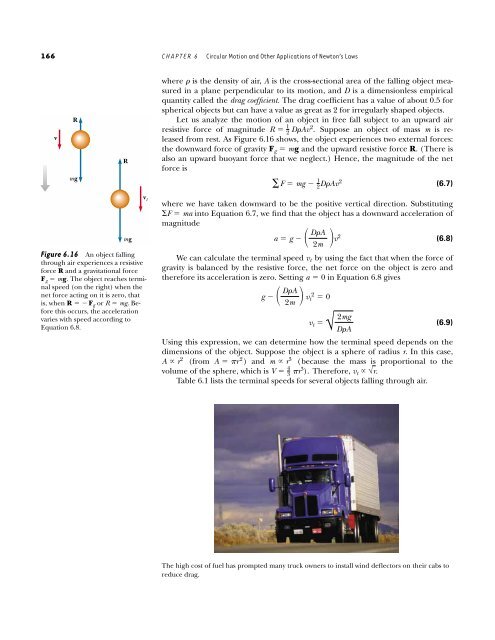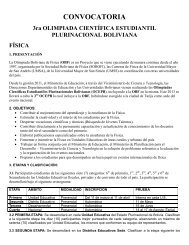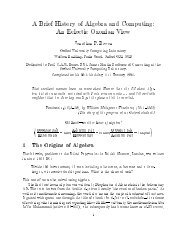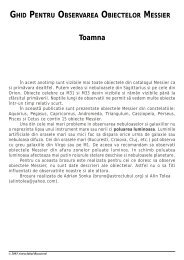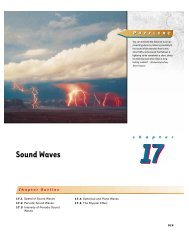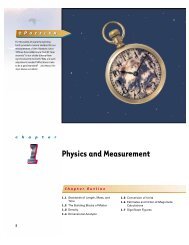Circular Motion and Other Applications of Newton's Laws
Circular Motion and Other Applications of Newton's Laws
Circular Motion and Other Applications of Newton's Laws
Create successful ePaper yourself
Turn your PDF publications into a flip-book with our unique Google optimized e-Paper software.
166 CHAPTER 6 <strong>Circular</strong> <strong>Motion</strong> <strong>and</strong> <strong>Other</strong> <strong>Applications</strong> <strong>of</strong> Newton’s <strong>Laws</strong><br />
v<br />
R<br />
mg<br />
R<br />
mg<br />
Figure 6.16 An object falling<br />
through air experiences a resistive<br />
force R <strong>and</strong> a gravitational force<br />
F g � mg. The object reaches terminal<br />
speed (on the right) when the<br />
net force acting on it is zero, that<br />
is, when R ��F g or R � mg. Before<br />
this occurs, the acceleration<br />
varies with speed according to<br />
Equation 6.8.<br />
v t<br />
where � is the density <strong>of</strong> air, A is the cross-sectional area <strong>of</strong> the falling object measured<br />
in a plane perpendicular to its motion, <strong>and</strong> D is a dimensionless empirical<br />
quantity called the drag coefficient. The drag coefficient has a value <strong>of</strong> about 0.5 for<br />
spherical objects but can have a value as great as 2 for irregularly shaped objects.<br />
Let us analyze the motion <strong>of</strong> an object in free fall subject to an upward air<br />
resistive force <strong>of</strong> magnitude R � Suppose an object <strong>of</strong> mass m is released<br />
from rest. As Figure 6.16 shows, the object experiences two external forces:<br />
the downward force <strong>of</strong> gravity Fg � mg <strong>and</strong> the upward resistive force R. (There is<br />
also an upward buoyant force that we neglect.) Hence, the magnitude <strong>of</strong> the net<br />
force is<br />
1<br />
2 D�Av2 .<br />
�F � mg � 1<br />
2 D�Av2<br />
(6.7)<br />
where we have taken downward to be the positive vertical direction. Substituting<br />
�F � ma into Equation 6.7, we find that the object has a downward acceleration <strong>of</strong><br />
magnitude<br />
a � g �� D�A<br />
2m � v2<br />
(6.8)<br />
We can calculate the terminal speed v t by using the fact that when the force <strong>of</strong><br />
gravity is balanced by the resistive force, the net force on the object is zero <strong>and</strong><br />
therefore its acceleration is zero. Setting a � 0 in Equation 6.8 gives<br />
g �� D�A<br />
2m � v 2<br />
t � 0<br />
(6.9)<br />
Using this expression, we can determine how the terminal speed depends on the<br />
dimensions <strong>of</strong> the object. Suppose the object is a sphere <strong>of</strong> radius r. In this case,<br />
(from A � �r 2 ) <strong>and</strong> (because the mass is proportional to the<br />
volume <strong>of</strong> the sphere, which is V � Therefore, vt � √r.<br />
Table 6.1 lists the terminal speeds for several objects falling through air.<br />
4<br />
3 �r3 m � r<br />
).<br />
3<br />
A � r2 vt � √ 2mg<br />
D�A<br />
The high cost <strong>of</strong> fuel has prompted many truck owners to install wind deflectors on their cabs to<br />
reduce drag.


